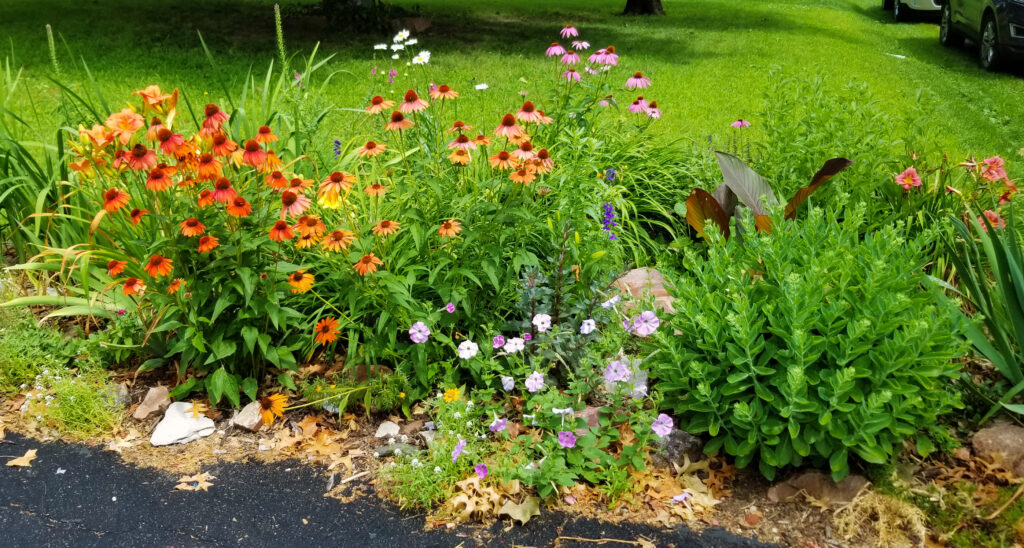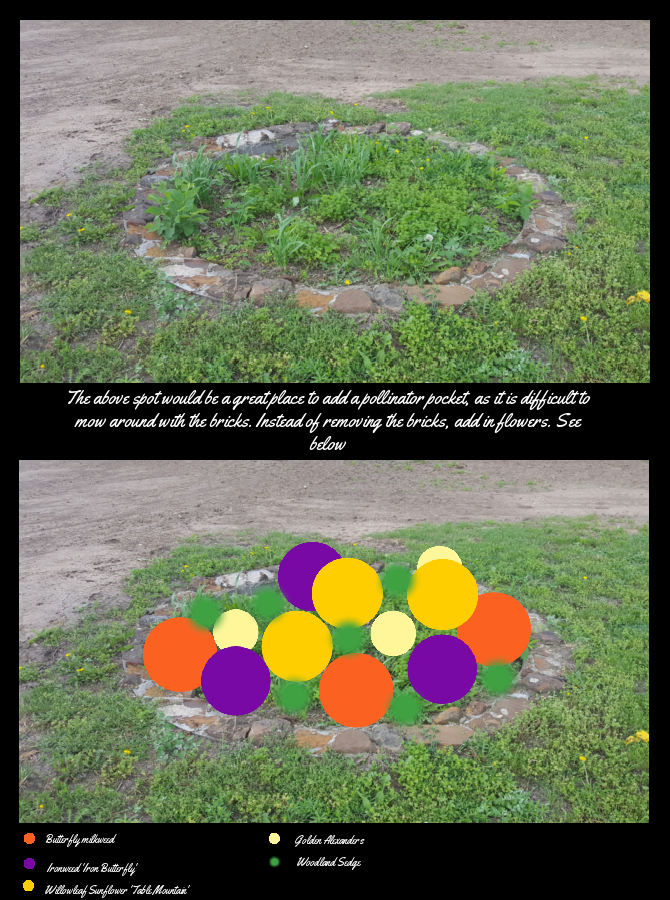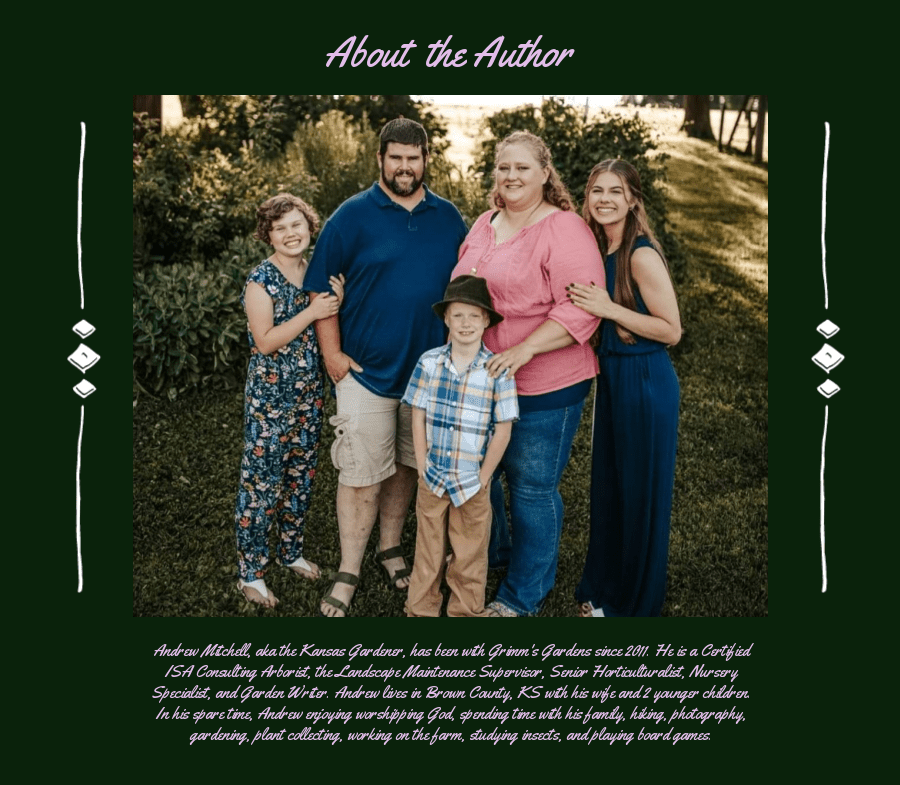What are pollinator pockets? Well, there is no official term for it, but pollinator pockets are small pieces of garden just for pollinators. It could be any size, but by my definition, it would be no larger than a 10 foot by 10 foot bed. However, the possibilities of a pollinator pocket are not small, for you could do it in containers, a recycled bath tub, a raised bed, even a rusty truck bed. Only your imagination limits you when providing food for pollinators.
But what kind of things go into pollinator pockets? Well, you need food for caterpillars and adult pollinators (bees, butterflies, moths, wasps, flies). And it should be colorful, fun, and add interest to your home or landscape. The amount of plants you can use in these spaces is limited by space, but you may be surprised how many plants can fit into a small space.
What Kind of Things are Great for Pollinator Pockets?
I already mentioned a few above. But there are so many things that can be filled with plants. If you live in the city and only have a balcony or small deck/patio, you can still have a place for pollinators with a tub or container garden. Or you can use railing boxes. Or hanging baskets.
Sometimes, a person may have to deal with an HOA which does not allow for messy garden or landscape space. And many times, pollinator plants can be messy, especially if caterpillars are left on the plant. What to do then? I would definitely recommend pollinator pockets in that situation. A half whiskey barrel with milkweed might be all you need.

Containers and Spaces for Pollinator Pockets
- Half whiskey barrel
- Recycled bath tub
- Galvanized wash tubs
- Ceramic pots
- Raised beds
- Water troughs
- Rusty truck beds
- Radio flyer wagon
- An old dresser
- Repurposed tool boxes
- File cabinet boxes
- Baskets
- Unused garden spaces
- Small pieces of lawn which are difficult to mow
Pollinator Host Plants for Small Spaces
While most plants provide something for pollinators (nectar, pollen, host), not all are suitable for small spaces or combine multiple features. But there are a number of plants which are quite useful in small spaces and great for pollinator pockets. Host plants not only provide pollen and nectar when blooming, but also allow caterpillars of moths and butterflies to feed on them. Below is a list of host plants for small spaces.
Host Plants That are 2 Feet Tall and Wide or Less
- Butterfly milkweed, Asclepias tuberosa
- Spider milkweed, Asclepias viridis
- Cream wild indigo, Baptisia bracteata
- Spike blazingstar, Liatris spicata
- Showy penstemon, Penstemon cobaea
- Golden Alexanders, Zizia aurea
- Purple prairie clover, Dalea purpurea
- Woodland sedge, Carex blanda
- Prairie violet, Viola pedatifida

Host Plants That are 2-4 Feet Tall and Wide
- Coneflowers, Echinacea species
- Blue wild indigo, Baptisia australis
- Swamp milkweed, Asclepias incarnata
- Aromatic aster, Symphyotrichum oblongifolium
- Rudbeckia ‘American Gold Rush’
- Prairie blazingstar, Liatris pyncnostachya
- Little bluestem, Schizachyrium scoparium
- Mexican hat, Ratibida columnifera
- Coralberry, Symphoricarpos orbiculatus
- Obedient plant, Physostegia angustifolia

Small Host Trees and Shrubs for Pollinator Pockets
- Eastern redbud, Cercis canadensis
- Wafer ash, Ptlea trifolia
- Dwarf chinkapin oak, Quercus prinoides
- Sandbar willow, Salix exigua
- Serviceberry, Amelanchier canandensis
- Red chokeberry, Aronia arbutifolia
- Arrowwood, Viburnum dentatum
- Sandhill plum, Prunus angustifolia
- Prickly-ash, Zanthoxylum americanum

Feeder Plants for Pollinator Pockets
These of course include plants not considered major host plants of moths and butterflies. However, they are quite important for a number of species, including bees, wasps, butterflies, flies, beetles, and more for their pollen and nectar. Adding as many of them as possible into pollinator pockets will help with overall biodiversity of the site.
Pollinator Plants Under 2 Feet Tall and Wide
- Ornamental onions, Allium species and cultivars
- Slender mountain mint, Pycnanthemum tenufolium
- Yarrow, Achillea species
- Calamint, Calamintha nepeta
- Blanketflower, Gaillardia species
- Willowleaf Sunflower ‘First Light’ & ‘Table Mountain’
- Lavender, Lavendula species
- Catmint ‘Cat’s Pajamas’, ‘Picture Purrfect’, & ‘Whispurr Pink’
- Ornamental Oregano ‘Drops of Jupiter’
- Meadow Sage, Salvia species
- Betony, Stachys species
- Tall Sedum, Hylotelephium
- Ironweed ‘Iron Butterfly’
- Milkweed ‘Hello Yellow’

Pollinator Plants Under 4 Feet Tall and Wide
- Blunt mountain mint, Pycnanthemum muticum
- Hummingbird mint, Agastache species
- Beebalm, Monarda species
- Culver’s Root, Veronicastrum virginicum
- Goldenrod ‘Fireworks’ & ‘Wichita Mountains’
- Greyhead coneflower, Ratibida pinnata
- Bluestar, Amsonia species
- Rattlesnake master, Eryngium yuccafolium
- Joe Pye Weed ‘Little Joe’
- Sneezeweed, Helenium autumnale
- False sunflower, Heliopsis helianthoides
- Rudbeckia ‘Henry Eilers’

Small Trees and Shrubs for Pollinator Pockets
- American bladdernut, Staphylea trifolia
- Bush honeysuckle, Diervilla lonicera
- Eastern ninebark, Physocarpos opulifolius
- Black elderberry, Sambucus canadensis

Planning and Planting
How do we put together these plants in such small spaces? Well, I like to see what kind of space I have first, and then choose the proper plants. If you are doing 3 half whiskey barrels, you can have 3 to 4 smaller (under 2 foot) plants in each. I would probably add annuals to one, and tough perennials to the others. My list might look like this:
- Butterfly milkweed, Spike blazingstar, prairie violet, ornamental oregano ‘Drops of Jupiter’
- Culver’s root, ironweed ‘Iron Butterfly’, Arkansas bluestar, woodland sedge
- Helenium ‘Dakota Gold’, dill, zinnia ‘Peppermint Stick’, sweet alyssum
But the combinations can be nearly endless. The above lists are just some of the plants available for small garden spaces. And these are mostly just for the Central Great Plains and Midwest regions. You may have more regionally specific plants that you want to use in your pollinator pockets.
When I am planning these gardens for customers, I try to use plants which bloom for long periods or overlap other plant’s bloom times, so I get as much continuous bloom as possible.
Conclusion
Pollinator pockets can fit into almost every garden, from the largest lot to a small sunny patio. But no matter where you live, you can enjoy having the buzz of bees and other pollinators visiting flowers you grow. Just find a spot and go for it.
Happy planting!




